When we power our Arduino sensor on battery we can use step up regulator. You can often read that step up regulator is a good choice if you want to extend operation time of your sensor. It can convert input voltage as low as 0.7V to output 3.3 V or 5V. And efficiency of this regulator can be up to 95%. To test this we create some simple tests.
We use one of step up regulators from Ebay. We test this regulator:
DC/DC ( Input 0.8-3V) ( Output 3.3V ) Step-UP Power Converter Voltage Module RF
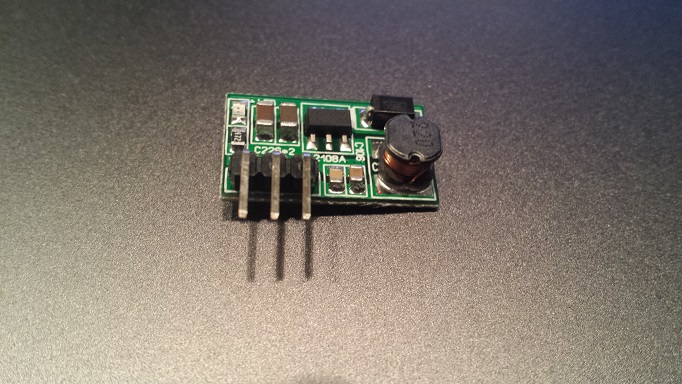
Here are some specs:
- Input voltage 0.8 ~ 3.3V, output 3.3V
- Maximum output current: 600 MA,
- Start Voltage 0.8V, Output Current 40MA
- INPUT 1-1.5V, OUTPUT 3.3V 50-120MA;
- INPUT 1.5-2V, OUTPUT 3.3V 120-180MA;
- INPUT 2-3V, OUTPUT 3.3V 180-400MA;
- INPUT above 3V, OUTPUT 3.3V 400-600MA;
- DC-DC Boost module working frequency 100KHZ. efficiency is normal 80% , can be up to 95%. On-board high-precision,
- Size : 24mm X12mm (length X width),
- The input and output terminals using the wire bonding connection, the selection of a plurality of parallel filtering of tantalum capacitors, effectively filter out the power supply noise.
- Overcurrent burn out warranty!
- Booster plate, regulator, the output voltage is always 3.3V!
We bought one of this regulators and test it in different conditions to see if we extend sensor operation time on battery. Don't forget, that our goal is to build sensor node which can run at least one year on two AA alkaline battery cells.
Our test scenario was:
- running step up regulator on two AA batteries without output current
- running step up regulator on two AA batteries and 220 ohm resistor on output
- running step up regulator on one AA battery (simulate two empty AA batteries) and 220 ohm resistor on output
You may ask why we choose 220 ohm resistor. Our sensor NRF24L01 transceiver consume about 15mA when transmitting. At 3.3V and 220 ohm current is 3.3V / 220ohm = 15 mA
Running step up regulator on two AA batteries without output current
First we test regulator without output current just to see current consumption of regulator.
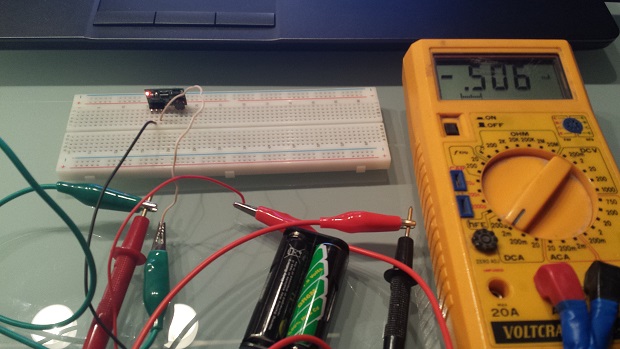
As we can see, current consumption is 0.506 mA. Typical AA alkaline battery capacity is 2900 mA. We can calculate:
T = 2900mA / 0.506mA = 5731.2 hours = 238.8 daysThat't not even one year only for step up regulator! We want our sensor to run one year on battery. Ok, we can easily see, that LED on step up regulator consumes most of the current. We removed LED and try again.
Input current is now: 0.022mA. That is much better, only 22µA.
If we use AA cells that is:
T = 2900mA / 0.022mA = 15,42 yearsThis is only in theory, because self discharging current of battery is couple of times higher.
Running step up regulator on two AA batteries and 220 ohm resistor on output
In second scenario we use two new alkaline batteries. Input voltage was 3.22V, output voltage 3.45V and current consumption at input 22.9mA.
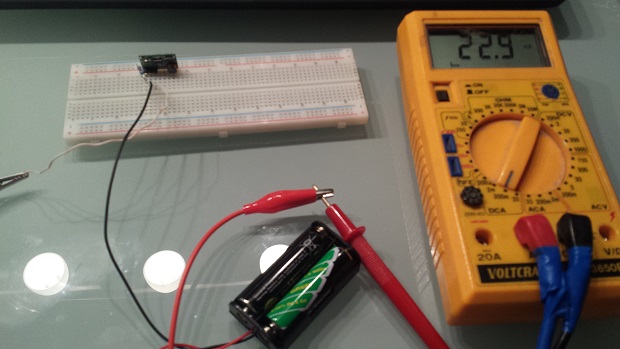
Output current is: 3.45V/220 ohm = 15.68 mA
We can calculate efficency:
efficiency = output power / input power = 3.45V * 15.68mA / 3.22V * 22.9mA = 73.36%
So we can see, that efficiency is less then efficiency in advertisement on Ebay.
Running step up regulator on one AA battery (simulate two empty AA batteries) and 220 ohm resistor on output
Now output voltage is 3.4V and input current 58.6mA.
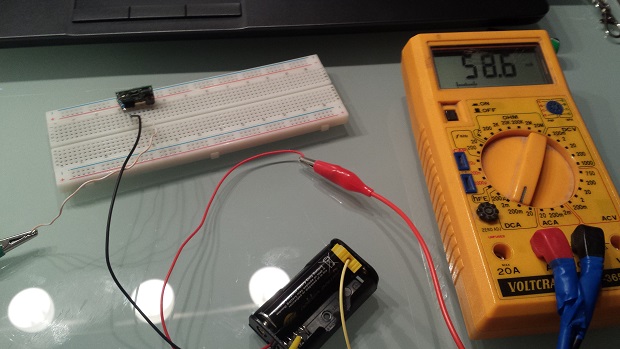
Output current is: 3.4V/220 ohm = 15.45mA
We can calculate efficiency:
Efficiency = output power / input power = 3.4V * 15.45mA / 1.61V * 58.6mA =55.67%
So we see the efficiency is even lower.
We can calculate average efficiency of regulator ( 73.36% + 55.67% ) / 2 = 64,5%
Conclusion
To interpretate our results we must see battery discharge chart. For example next picture shows discharge chart at 200mA for Duracel satndard AA cell.
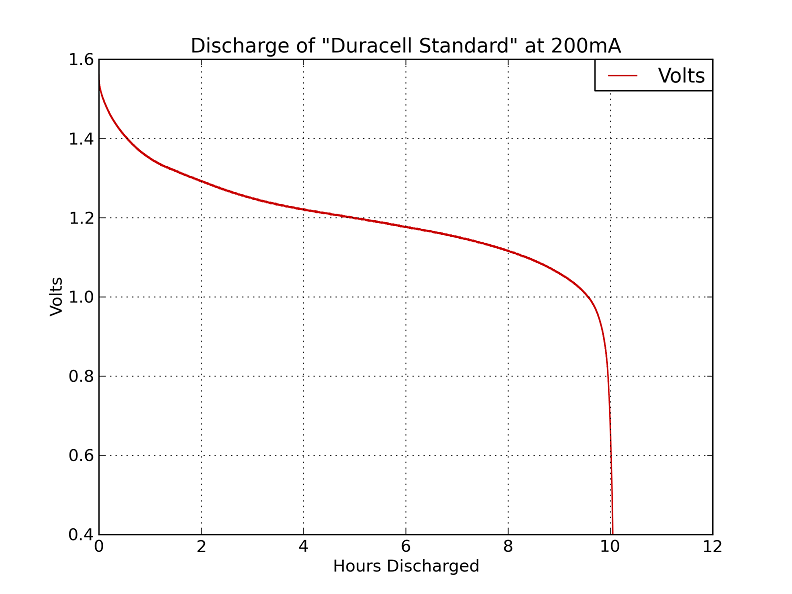
We can see that at 200mA discharge current battery can operate 10 hours. That means 2000mAh. At lower discharge current we can get more mAh up to 2900mAh for AA alkaline battery. For lower current discharge curve is similar except it is expanded along X-axis.
For our example we can use this discharge curve and calculate operating hours. If we have components which can operate on 2V (NRF24L01 can operate at 1.8V) we can get at 200mA * 9.5h = 1800mAh.
If we use step up regulator we can get only additional 200mAh but you must take into account efficiency of step up regulator. Even if we get 2000mAh out of battery our sensor gets only
capacity * efficiency = 2000mAh * 64,5% = 1290mAh
Even if we use step up regulator with 95% efficiency we can get only:
2000 mAh * 95% = 1900 mAh
Almost the same as without step up regulator. But typical efficiency of step up regulator is less than 95%. See efficiency for TPS61220. At lower current or lower input voltage is less than 80%.
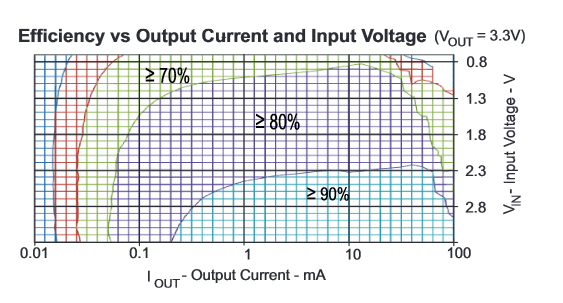
What is better to use step up regulator or not? It depends. If we have components which require 3.3V or 5V then we need step up regulator when battery voltage drops. But if we carefully select components which can operate at lover voltages ( to 1.8 V) we can get more mAh ( operating hours ) for our sensor without step up regulator.
See more tutorials at http://iot-playground.com/build